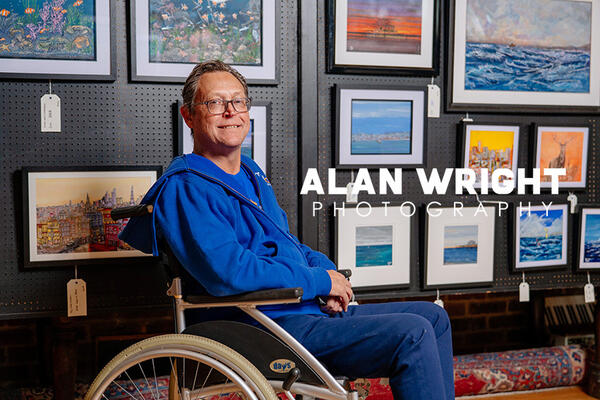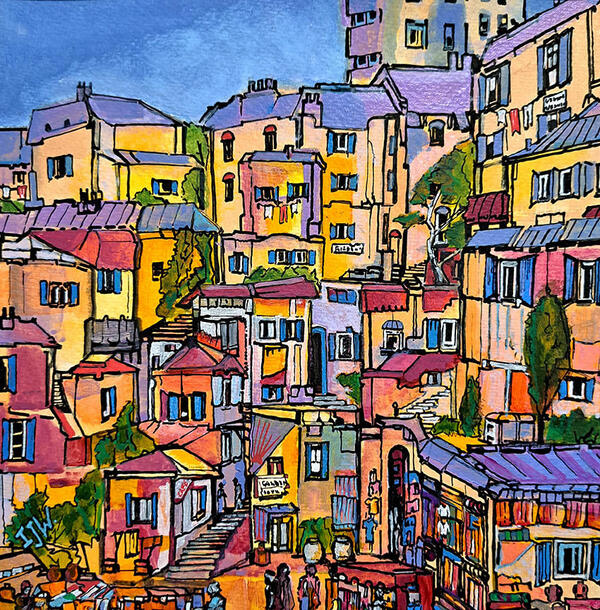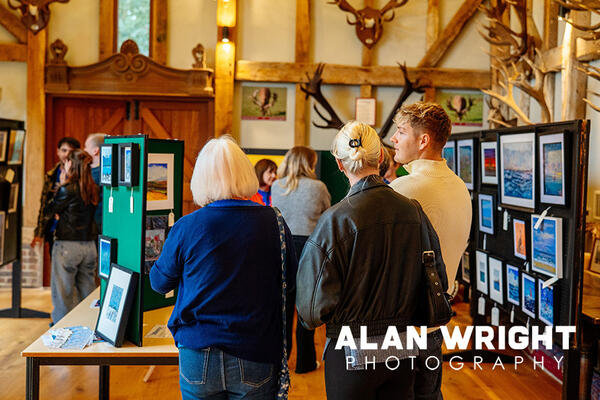SOUTHWATER ARTIST IAN WALDER

Published on 1st October 2025
Southwater artist Ian Walder suffers from a rare form of Motor Neurone Disease (MND). As the degenerative disease progresses, it impacts the scale and scope of his work. However, an exhibition at Warnham Deer Park in September revealed the full variety of Ian’s joyous, vibrant paintings. AAH visited to hear about his journey…
When were you diagnosed with MND?
Three years ago. I was struggling with breathing, had low energy levels and was experiencing fasciculations – involuntary twitches – in my legs. A rheumatologist referred me to a neurologist, who carried out various tests to assess my nerve and muscle functions. I had an MRI scan and remember feeling happy when the results revealed I didn’t have a brain tumour. Gradually, we ticked off the things I didn’t have. Then, my doctor asked me to come in to the surgery with my wife, Jane. I expected to hear that I was suffering from a neurological disease; I never expected to be told I had MND.
How did you react?
I didn’t know much about MND prior to my diagnosis. But I knew there was no cure and that it progressively attacks the nerves that control the body’s movement. Initially, I was in denial, as I considered myself to be a fit and healthy person. I had run half marathons, played golf regularly and was enjoying life. So, it was a huge shock and there have been difficult moments that I’ve tried to work through with support from my family and friends.
How long have you been painting?
On-and-off for about 40 years. I didn’t really enjoy art at school, but did study technical drawing and utilised some of these skills while working for my dad’s company, Dorking Litho Printers, as a graphic designer. When my dad had to stop working, I stepped up to the role of director and that’s how I developed the gift of the gab! Unfortunately, Covid signalled the end for the business, although the print industry was already struggling, but we helped all of our staff find new jobs.

Has your art evolved with time?
For many years, I only painted sporadically. In the past decade, I’ve been more prolific in terms of output and it’s only during this time that I feel my work has been good enough to hang on walls. I remember the happiness of selling my first painting. It felt like I had put one foot on the bottom rung of a ladder. One sale put me on the bottom rung and I’ve progressed three or four steps since then, which means I get to sell a few pieces. I don’t think that means my art is necessarily any less accomplished than somebody near the top; they might have just been working at it longer.
Is it too clichéd to describe painting as an escape for you?
I don’t think so; it is an escape. I even listen to audiobooks which transport me to a different place. I still associate paintings with the book I was listening to when I created them. When I see my scene of Venice, I immediately think of The Count of Monte Cristo!
You paint a wide variety of subjects…
I work on landscapes, seascapes and cityscapes, depending on my mood. Even though the subject matter varies greatly, I think there is consistency across my work, even if my style is expressed in different ways. I begin each painting with an acrylic background, then work with fine-tip pens to add detail, leaning on my technical drawing background. Sometimes, I leave the pens in the drawer and paint more expressive, free-flowing seascapes. Occasionally, I even use wall filler to create raised layers within a cityscape, adding a different perspective to the scene.
Do you visit the places you paint?
Nearly everything I’ve painted, from the Rocky Mountains to the Italian coast, stems from my own visual memories. Some of my Canadian landscapes have been created entirely from my imagination, albeit inspired by the scenery. I take photos I can refer back to, but try to focus on my feelings of a place, often making mental notes regarding the lighting and shadows of a scene. However, there are no rules when it comes to colour, where I can be more expressive. I think that’s what people most enjoy about my art.

How has MND impacted your work?
I am experiencing more fasciculations as the disease progresses and weakens my body. I’ve already had to move away from working on large cityscapes (such as the Venice scene, above right) as they take too long and I’m no longer able to paint for hours. Sometimes, I spend too long in the studio and reach a point where I can barely move my arms. But the next day, I still pick up a brush again. All artists evolve their style, but my hand has been forced by changing physical capabilities. However, I have enjoyed creating my most recent paintings of aqua landscapes.
How did the exhibition come about?
My friend Jim Dunne is largely responsible. I held a small exhibition at Rookwood Golf Club a couple of years ago, mostly attended by friends and family. Jim orchestrated this event as he felt my work was worthy of a wider audience. So, at the age of 60, I have the chance to savour my first proper exhibition! Jim managed to gain support from Jonathan, Caroline and Charles Lucas, who gave us permission to use Drew’s Barn at Warnham Deer Park. It’s the most beautiful venue, both inside and out, and occasionally we’ve seen stags only yards away from the barn entrance.
You are fundraising for a good cause too…
I am donating 20% of all sales to the North Sussex branch of the MNDA, which has supported the exhibition, with volunteers serving hot drinks and cakes to visitors. I’m delighted to say that we’ve sold almost all of the paintings and received commissions too, particularly for different versions of Into the Blue, a painting of a lone sailboat. I am still able to walk for short distances with the help of a rollator, but I hope to raise enough money to buy a lightweight wheelchair. Basic models are provided by the NHS, but a more advanced model will help me move around more comfortably and live as normal a life as possible.
How do you reflect on the exhibition?
It was a wonderful weekend and I met some lovely people. My family and friends could see that I was becoming tired by Sunday afternoon and suggested that I rest at home for a while. But I wanted to stay and meet everyone. I have this mentality that I don’t want to give up. Not on anything. The MND means it has been exhausting, but I have a marathon mentality that helps drive me on.
WORDS: Ben Morris / PHOTOS: Alan Wright
Further information: You can see more of Ian’s work at www.ijwhorshamart.com


